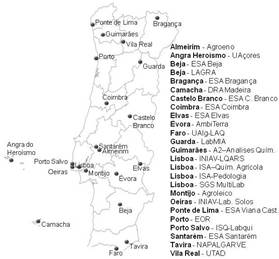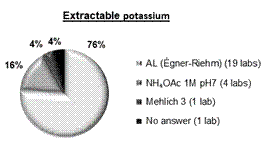INTRODUCTION
Knowledge of the state of soil fertility, through soil analysis, is essential to enable the establishment of a rational fertilization plan, fundamental to ensure good crop production, in a context of increasing economic and environmental constraints.
The main objectives of this work were: (1) to survey the soil fertility labs operating in Portugal; (2) to know what other matrices were analysed, related to crop fertilisation and nutrition; (3) to know which analytical methodologies were predominantly used.
MATERIAL AND METHODS
In March 2022 a survey was sent to the Heads of 32 soil analysis laboratories in Portugal. 25 labs responded to the survey. Of the 7 labs that did not respond: 3 informed that they did not perform soil fertility analysis; 2 (Eurofins Agrotesting and AGQ labs.) informed that they receive samples, but these are analysed in a lab based outside the country, choosing not to respond to the survey; 2 labs, despite confirming to analyse soil fertility, did not respond.
Location of the laboratories
Most of the laboratories belong to the Ministry of Education (14), 4 belong to the Ministry of Agriculture and 7 are private, spread over the mainland and islands (Figure 1). In 16 of them, most of the analyses performed in 2021 were for direct support to agricultural activity.
Materials analysed within the frame- work of soil fertility, plant nutrition and crop fertilization
Nearly all labs analysing soil also analyse plant material. This is followed by organic soil improver (68 % of the labs) and irrigation water (64 %). To a lesser extent fertilizer (36 %) and liming material (32 %) (Table 1).
Table 1 Materials analysed by the different labs
| Location | Laboratory | S | PM | IW | F | LM | OSI |
|---|---|---|---|---|---|---|---|
| Almeirim | Agroeno | × | × | × | × | ||
| A. Heroísmo | UAçores | × | × | × | |||
| Beja | ESA Beja | × | |||||
| Beja | LAGRA | × | × | × | × | × | × |
| Bragança | ESA Bragança | × | × | × | |||
| Camacha | DRA Madeira | × | × | × | |||
| C. Branco | ESA C. Branco | × | × | × | |||
| Coimbra | ESA Coimbra | × | × | × | × | ||
| Elvas | ESA Elvas | × | × | × | × | ||
| Évora | AmbiTerra | × | × | × | |||
| Faro | UAlg-LAQ | × | × | × | × | × | × |
| Guarda | LabMIA | × | × | × | × | ||
| Guimarães | A2-Análises Quím. | × | × | × | × | × | × |
| Lisboa | INIAV-LQARS | × | × | × | × | × | × |
| Lisboa | ISA-Quím. Agríc. | × | × | × | × | ||
| Lisboa | ISA-Pedologia | × | × | × | × | ||
| Lisboa | SGS MultiLab | × | × | × | × | ||
| Montijo | Agroleico | × | × | × | × | × | × |
| Oeiras | INIAV-Lab. Solos | × | × | × | × | × | |
| Pte. Lima | ESA V. Castelo | × | × | × | |||
| Porto | EOR | × | × | × | |||
| Porto Salvo | ISQ-Labqui | × | × | × | × | × | |
| Santarém | ESA Santarém | × | × | ||||
| Tavira | NAPALGARVE | × | × | × | |||
| Vila Real | UTAD | × | × | × | × |
S - Soil; PM - Vegetal material; IW - Irrigation water; F - Fertilizer; LM - Liming material; OSI - Organic soil improver.
Parameters currently analysed for the purpose of fertilisation recommen-dations
The labs generally propose analytical programmes, simpler for annual crops, or more complete for the establishment of tree or shrub crops. The analytical package commonly called summary analysis (SA) generally includes the extractable content of the main nutrients, as well as the three parameters that most influence both the availability of these nutrients to the plant and the capacity of the soil to retain water: pH, organic matter (OM) and texture (Table 2).
Table 2 Parameters covered in the Summary analysis programme and issuing of fertilisation recommendations
| Laboratory | pH | OM | P | K | FT | Mg | N | LR | O | FR |
|---|---|---|---|---|---|---|---|---|---|---|
| Agroeno | (1,2) | × | × | × | × | × | n | |||
| UAçores | (1) | × | × | × | × | × | × | a | ||
| ESA Beja | (1) | × | × | × | × | or | ||||
| LAGRA | (1) | × | × | × | × | × | × | × | or | |
| ESA Bragança | (1,2) | × | × | × | a | |||||
| DRA Madeira | (1,2) | × | × | × | n | |||||
| ESA C. Branco | (1) | × | × | × | × | or | ||||
| ESA Coimbra | (1) | × | × | × | × | × | or | |||
| ESA Elvas | (1,2) | × | × | × | × | × | × | or | ||
| AmbiTerra | (1) | × | × | × | × | × | or | |||
| UAlg-LAQ | (1) | × | × | × | × | × | × | or | ||
| LabMIA | (1,2) | × | × | × | × | n | ||||
| A2-Anális. Quím. | (1,3) | × | × | × | × | × | × | × | a | |
| INIAV-LQARS | (1) | × | × | × | × | × | × | a | ||
| ISA-Quím. Agríc. | (1) | × | × | × | × | × | × | or | ||
| ISA-Pedologia | (1) | × | × | × | × | × | or | |||
| SGS MultiLab | (1) | × | × | × | × | × | n | |||
| Agroleico | (1,2,3) | × | × | × | × | × | × | n | ||
| INIAV-Lab. Solos | (1) | × | × | × | × | × | × | n | ||
| ESA V. Castelo | (1) | × | × | × | × | × | × | or | ||
| EOR | (1,2) | × | × | × | × | × | × | × | or | |
| ISQ-Labqui | (1,2,3) | × | × | × | × | × | × | or | ||
| ESA Santarém | (1) | × | × | × | × | × | or | |||
| NAPALGARVE | (1) | × | × | × | × | × | × | × | or | |
| UTAD | (1,2) | × | × | × | × | × | a |
(1) pH-H₂O; (2) pH-KCl; (3) pH-CaCl₂; FT - Field texture; N - total nitrogen; LR - Lime requirement; O - Other parameters; FR - fertiliser recommendations; n - no; or - on request; a - always.
It was found that there is a great variability in the parameters proposed by the labs: pH, OM, extractable phosphorus (P) and potassium (K) are always included in the SA. The same is not true for the other parameters, field texture being included in 72 % of the cases, extractable magnesium (56 %), "lime" requirement (44 %) and total nitrogen (32 %).
The issue of fertiliser recommendations by the labs is a clear advantage for the farmers, who thus have a good basis for rational fertilization of their crops. 19 of the 25 surveyed labs (76 %) issue fertiliser recommendations, but in only 5 labs are these done automatically. In the remaining 14, only on request (Table 2).
Analytical methodology followed in the Summary Analysis parameters
Harmonisation of methods is important at a world and national level, in order to improve the comparability of results. It is, however, difficult to achieve, especially in the case of plant-available nutrients, as it involves much more than laboratory analysis (history of studies, such as field trials, type of soils, etc.). In 2017 FAO launched the Global Soil Laboratory Network (GLOSOLAN), involving more than 740 laboratories worldwide. It aims to harmonise many of the operating procedures in this area, making them freely available.
pH: All labs include pH-H₂O in the SA. Seven of them also use pH-KCl and two include in addition pH-CaCl₂. The proportion soil: extractant is 1:2.5 (m/v) in 64 % of the labs, being 1:5 v/v (ISO 10390 standard) in 32 % of the labs (Figure 2).
Organic matter: Except in the case of loss on ignition, OM is always obtained by multiplying the soil organic carbon (SOC) content by 1.724. Dry combustion is the method which gives the total SOC content. It is the preferred one in international studies (FAO, 2020), being followed by 6 labs. However, most labs (15) use dichromate oxidation, either potassium dichromate (8) or sodium dichromate (7).
Due to the incomplete oxidation of SOC by dichromate (circa 77 %), a correction factor of 1.3 has been proposed (Kalra & Manyard, 1992; FAO, 2020). This factor was confirmed by Dias et al. (2005) for Portuguese soils. However, only 5 of the 15 labs employing dichromate said they use a correction factor. Other 7 do not use it and 3 did not answer. The use of this correction factor should be very clear in the analysis report, to allow a proper comparison of results from different laboratories.
P and K are extracted using the Ammo-nium lactate/acetic acid method (Egnér et al., 1960) in about 80% of the laboratories, but ¼ of them also use the Olsen method for P (Olsen et al., 1954), depending on the pH of the soil. For Mg, 1M ammonium acetate at pH7 predo-minates. The lime requirement is obtained by calculation in 15 of the 25 labs and dosed in 5 others.
Only two of the labs - ISQ and Lagra - have accredited tests. Several labs indicated the need for a National soil testing programme, for proficiency testing and methodology harmonisation.
CONCLUSIONS
In Portugal, there is a large network of 25 soil fertility labs. pH, OM, extractable P and K are the parameters always analysed in the minimum analytical programme. There is a relative homogeneity of methods for these parameters, except for organic matter. 76 % of the labs issue fertiliser recommendations, but only 20 % do so automatically. Only two have accredited tests. There is a need for a national soil testing programme.
















